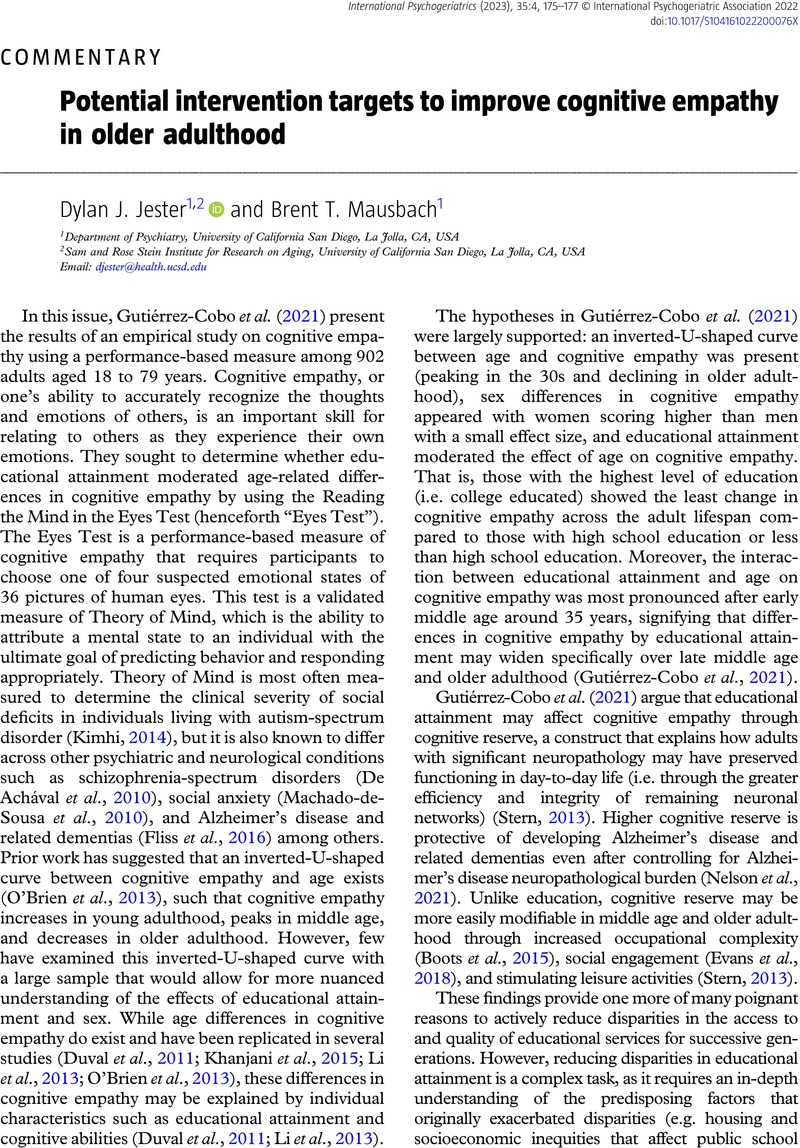No CrossRef data available.
Article contents
Potential intervention targets to improve cognitive empathy in older adulthood
Published online by Cambridge University Press: 01 September 2022
Abstract
An abstract is not available for this content so a preview has been provided. Please use the Get access link above for information on how to access this content.

- Type
- Commentary
- Information
- International Psychogeriatrics , Volume 35 , Special Issue 4: Issue Theme: Cognitive Resilience, Empathy, and Self-compassion , April 2023 , pp. 175 - 177
- Copyright
- © International Psychogeriatric Association 2022
References
Boots, E. A. et al. (2015). Occupational complexity and cognitive reserve in a middle-aged cohort at risk for Alzheimer’s disease. Archives of Clinical Neuropsychology, 30, 634–642.CrossRefGoogle Scholar
De Achával, D. et al. (2010). Emotion processing and theory of mind in schizophrenia patients and their unaffected first-degree relatives. Neuropsychologia, 48, 1209–1215.CrossRefGoogle ScholarPubMed
Duval, C., Piolino, P., Bejanin, A., Eustache, F. and Desgranges, B. (2011). Age effects on different components of theory of mind. Consciousness and Cognition, 20, 627–642.CrossRefGoogle ScholarPubMed
Evans, I. E. et al. (2018). Social isolation, cognitive reserve, and cognition in healthy older people. PloS One, 13, e0201008.CrossRefGoogle ScholarPubMed
Fliss, R., Le Gall, D., Etcharry-Bouyx, F., Chauviré, V., Desgranges, B. and Allain, P. (2016). Theory of mind and social reserve: alternative hypothesis of progressive theory of mind decay during different stages of Alzheimer’s disease. Social Neuroscience, 11, 409–423.CrossRefGoogle ScholarPubMed
Gutiérrez-Cobo, M. J., Cabello, R., Megías-Robles, A., Gómez-Leal, R., Baron-Cohen, S. and Fernández-Berrocal, P. (2021). Does our cognitive empathy diminish with age? The moderator role of educational level. International Psychogeriatrics, 1–8.Google ScholarPubMed
Khanjani, Z. et al. (2015). Comparison of cognitive empathy, emotional empathy, and social functioning in different age groups. Australian Psychologist, 50, 80–85.CrossRefGoogle Scholar
Kimhi, Y. (2014). Theory of mind abilities and deficits in autism spectrum disorders. Topics in Language Disorders, 34, 329–343.CrossRefGoogle Scholar
Kirby, J. N., Tellegen, C. L. and Steindl, S. R. (2017). A meta-analysis of compassion-based interventions: current state of knowledge and future directions. Behavior Therapy, 48, 778–792.CrossRefGoogle ScholarPubMed
Lee, E. E. et al. (2020). Outcomes of randomized clinical trials of interventions to enhance social, emotional, and spiritual components of wisdom: a systematic review and meta-analysis. JAMA Psychiatry, 77, 925–935.CrossRefGoogle Scholar
Li, X., Wang, K., Wang, F., Tao, Q., Xie, Y. and Cheng, Q. (2013). Aging of theory of mind: the influence of educational level and cognitive processing. International Journal of Psychology, 48, 715–727.CrossRefGoogle ScholarPubMed
Lindbergh, C. A. et al. (2022). Wisdom and fluid intelligence are dissociable in healthy older adults. International Psychogeriatrics, 34, 229–239.CrossRefGoogle ScholarPubMed
Machado-de-Sousa, J. P. et al. (2010). Facial affect processing in social anxiety: tasks and stimuli. Journal of Neuroscience Methods, 193, 1–6.CrossRefGoogle ScholarPubMed
Nelson, M. E., Jester, D. J., Petkus, A. J. and Andel, R. (2021). Cognitive reserve, Alzheimer’s neuropathology, and risk of dementia: a systematic review and meta-analysis. Neuropsychology Review, 31, 233–250.CrossRefGoogle ScholarPubMed
O’Brien, E., Konrath, S. H., Grühn, D. and Hagen, A. L. (2013). Empathic concern and perspective taking: linear and quadratic effects of age across the adult life span. Journals of Gerontology Series B: Psychological Sciences and Social Sciences, 68, 168–175.CrossRefGoogle ScholarPubMed
Preckel, K., Kanske, P. and Singer, T. (2018). On the interaction of social affect and cognition: empathy, compassion and theory of mind. Current Opinion in Behavioral Sciences, 19, 1–6.CrossRefGoogle Scholar
Stern, Y. (2013). Cognitive reserve: implications for assessment and intervention. Folia Phoniatrica et Logopaedica, 65, 49–54.CrossRefGoogle ScholarPubMed
Tavares, L., Vagos, P. and Xavier, A. (2020). The role of self-compassion in the psychological (mal) adjustment of older adults: a scoping review. International Psychogeriatrics, 1–14.Google ScholarPubMed
Teding van Berkhout, E. and Malouff, J. M. (2016). The efficacy of empathy training: a meta-analysis of randomized controlled trials. Journal of Counseling Psychology, 63, 32–41.CrossRefGoogle ScholarPubMed
Treichler, E. B. et al. (2020). A pragmatic trial of a group intervention in senior housing communities to increase resilience. International Psychogeriatrics, 32, 173–182.CrossRefGoogle ScholarPubMed


